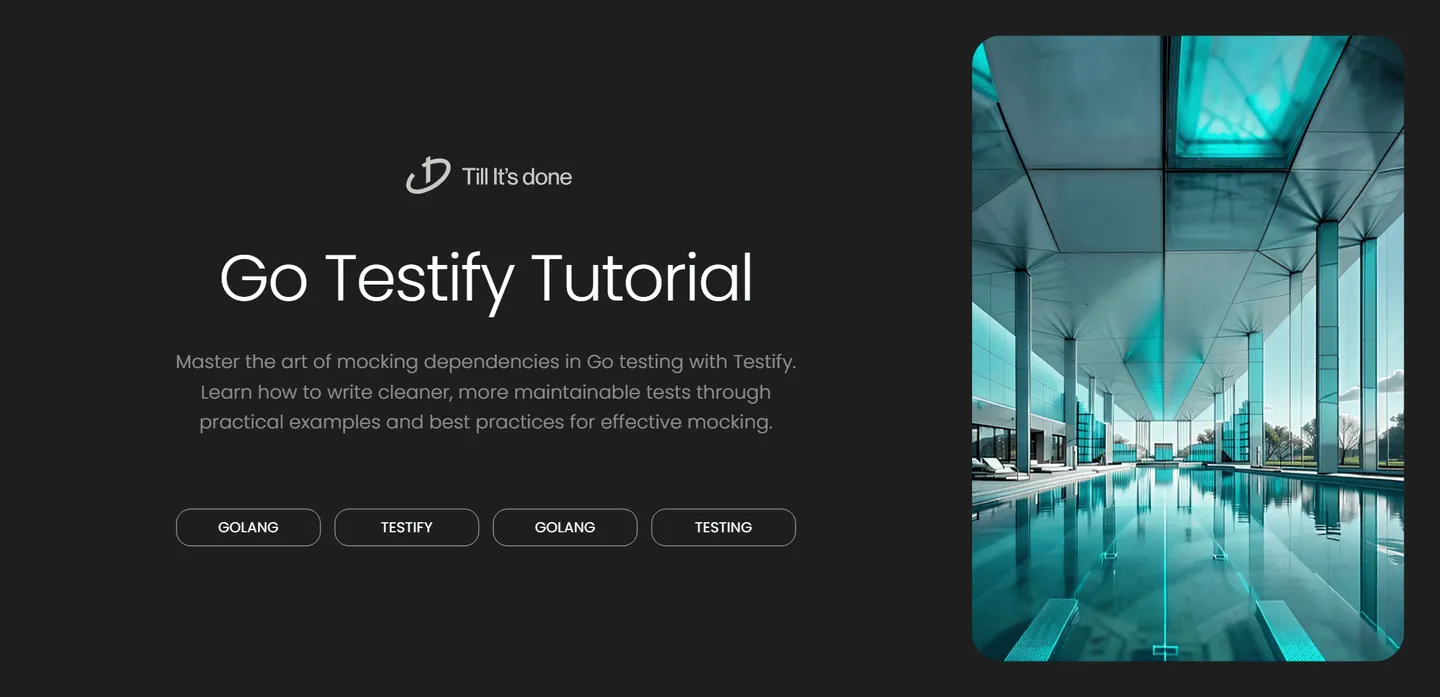- Services
- Case Studies
- Technologies
- NextJs development
- Flutter development
- NodeJs development
- ReactJs development
- About
- Contact
- Tools
- Blogs
- FAQ
Mocking Dependencies with Testify Guide
Learn how to write cleaner, more maintainable tests through practical examples and best practices for effective mocking.

Mocking Dependencies with Testify: A Beginner’s Guide

Testing in Go can be challenging, especially when your code has external dependencies. Whether it’s a database connection, an API call, or file system operations, these dependencies can make testing complex and unreliable. That’s where mocking comes in, and Testify makes it surprisingly straightforward.
Understanding the Basics of Mocking
Think of mocks as stand-in actors for your real dependencies. Just like how a stunt double replaces an actor for dangerous scenes, mocks replace real dependencies during testing. They help you control the testing environment and verify how your code interacts with these dependencies.

Getting Started with Testify Mocks
Let’s dive into a practical example. Imagine we have a simple user service that fetches user data from a database:
type UserRepository interface { GetUser(id string) (*User, error)}
type UserService struct { repo UserRepository}
func (s *UserService) GetUserDetails(id string) (*UserDetails, error) { user, err := s.repo.GetUser(id) if err != nil { return nil, err } return &UserDetails{ Name: user.Name, Email: user.Email, }, nil}To test this service without a real database, we can use Testify’s mock package:
func TestUserService_GetUserDetails(t *testing.T) { // Create a new mock repository mockRepo := new(mocks.UserRepository)
// Setup the mock expectation mockRepo.On("GetUser", "123").Return(&User{ Name: "John Doe", Email: "john@example.com", }, nil)
// Create service with mock service := &UserService{repo: mockRepo}
// Test the service details, err := service.GetUserDetails("123")
// Assert results assert.NoError(t, err) assert.Equal(t, "John Doe", details.Name) mockRepo.AssertExpectations(t)}Best Practices for Mocking
-
Mock at Interface Boundaries: Design your code around interfaces to make it more testable. This is where Go’s interface system really shines.
-
Mock What You Own: Focus on mocking your own interfaces rather than third-party ones. This gives you more control and makes your tests more stable.
-
Keep Mocks Simple: Only mock what you need. Excessive mocking can make tests complicated and brittle.

Advanced Mocking Techniques
Testify provides powerful features for more complex scenarios:
// Mock with argument matchersmockRepo.On("GetUser", mock.AnythingOfType("string")).Return(...)
// Mock sequential callsmockRepo.On("GetUser", "123"). Return(user1, nil).Once(). Return(user2, nil).Once()
// Mock error conditionsmockRepo.On("GetUser", "invalid").Return(nil, errors.New("not found"))Common Pitfalls to Avoid
- Over-mocking: Don’t mock everything. Sometimes using a real implementation is clearer and more valuable.
- Brittle Tests: Avoid testing implementation details. Focus on behavior.
- Complex Mock Setup: If your mock setup is getting complicated, it might be a sign that your code needs restructuring.
Remember, the goal of mocking is to make testing easier and more reliable, not to create an intricate web of fake objects. Keep it simple, focus on testing behavior, and use mocks judiciously.

 สร้างเว็บไซต์ 1 เว็บ ต้องใช้งบเท่าไหร่? เจาะลึกทุกองค์ประกอบ website development cost อยากสร้างเว็บไซต์แต่ไม่มั่นใจในเรื่องของงบประมาณ อ่านสรุปเจาะลึกตั้งแต่ดีไซน์, ฟังก์ชัน และการดูแล พร้อมตัวอย่างงบจริงจาก Till it’s done ที่แผนชัด งบไม่บานปลายแน่นอน
สร้างเว็บไซต์ 1 เว็บ ต้องใช้งบเท่าไหร่? เจาะลึกทุกองค์ประกอบ website development cost อยากสร้างเว็บไซต์แต่ไม่มั่นใจในเรื่องของงบประมาณ อ่านสรุปเจาะลึกตั้งแต่ดีไซน์, ฟังก์ชัน และการดูแล พร้อมตัวอย่างงบจริงจาก Till it’s done ที่แผนชัด งบไม่บานปลายแน่นอน  Next.js สอน 14 ขั้นตอนเบื้องต้น: สร้างโปรเจกต์แรกใน 30 นาที เริ่มต้นกับ Next.js ใน 14 ขั้นตอนเพียงแค่ 30 นาที พร้อม SSR/SSG และ API Routes ด้วยตัวอย่างโค้ดง่าย ๆ อ่านต่อเพื่อสร้างโปรเจ็กต์แรกได้ทันทีที่นี่
Next.js สอน 14 ขั้นตอนเบื้องต้น: สร้างโปรเจกต์แรกใน 30 นาที เริ่มต้นกับ Next.js ใน 14 ขั้นตอนเพียงแค่ 30 นาที พร้อม SSR/SSG และ API Routes ด้วยตัวอย่างโค้ดง่าย ๆ อ่านต่อเพื่อสร้างโปรเจ็กต์แรกได้ทันทีที่นี่  วิธีสมัคร Apple Developer Account เพื่อนำแอปขึ้น App Store ทีละขั้นตอน อยากปล่อยแอปบน App Store ระดับโลก มาอ่านคู่มือสมัคร Apple Developer Account พร้อมเคล็ดลับ TestFlight และวิธีอัปโหลดที่ง่ายในบทความเดียวนี้ได้เลย
วิธีสมัคร Apple Developer Account เพื่อนำแอปขึ้น App Store ทีละขั้นตอน อยากปล่อยแอปบน App Store ระดับโลก มาอ่านคู่มือสมัคร Apple Developer Account พร้อมเคล็ดลับ TestFlight และวิธีอัปโหลดที่ง่ายในบทความเดียวนี้ได้เลย  TypeScript Interface คืออะไร? อธิบายพร้อมวิธีใช้และข้อแตกต่างจาก Type เรียนรู้วิธีใช้ TypeScript Interface เพื่อสร้างโครงสร้างข้อมูลที่ปลอดภัยและเข้าใจง่าย พร้อมเปรียบเทียบข้อดีข้อแตกต่างกับ Type ที่คุณต้องรู้ ถูกรวมเอาไว้ในบทความนี้แล้ว
TypeScript Interface คืออะไร? อธิบายพร้อมวิธีใช้และข้อแตกต่างจาก Type เรียนรู้วิธีใช้ TypeScript Interface เพื่อสร้างโครงสร้างข้อมูลที่ปลอดภัยและเข้าใจง่าย พร้อมเปรียบเทียบข้อดีข้อแตกต่างกับ Type ที่คุณต้องรู้ ถูกรวมเอาไว้ในบทความนี้แล้ว  Material-UI (MUI) คืออะไร อยากสร้าง UI สวยงามและเป็นมืออาชีพในเวลาอันรวดเร็วใช่ไหม มาทำความรู้จักกับ Material-UI (MUI) ที่ช่วยให้คุณพัฒนาแอปพลิเคชันบน React ได้ง่ายและดูดีในทุกอุปกรณ์
Material-UI (MUI) คืออะไร อยากสร้าง UI สวยงามและเป็นมืออาชีพในเวลาอันรวดเร็วใช่ไหม มาทำความรู้จักกับ Material-UI (MUI) ที่ช่วยให้คุณพัฒนาแอปพลิเคชันบน React ได้ง่ายและดูดีในทุกอุปกรณ์  เปรียบเทียบ 3 วิธีติดตั้ง install node js บน Ubuntu: NVM vs NodeSource vs Official Repo แบบไหนดีที่สุด? เรียนรู้วิธีติดตั้ง Node.js บน Ubuntu ด้วย NVM, NodeSource หรือ Official Repo เลือกวิธีที่เหมาะกับความต้องการของคุณ พร้อมเปรียบเทียบ เพื่อการพัฒนาที่มีประสิทธิภาพ!
เปรียบเทียบ 3 วิธีติดตั้ง install node js บน Ubuntu: NVM vs NodeSource vs Official Repo แบบไหนดีที่สุด? เรียนรู้วิธีติดตั้ง Node.js บน Ubuntu ด้วย NVM, NodeSource หรือ Official Repo เลือกวิธีที่เหมาะกับความต้องการของคุณ พร้อมเปรียบเทียบ เพื่อการพัฒนาที่มีประสิทธิภาพ! พูดคุยกับซีอีโอ
We'll be right here with you every step of the way.
We'll be here, prepared to commence this promising collaboration.
Whether you're curious about features, warranties, or shopping policies, we provide comprehensive answers to assist you.


